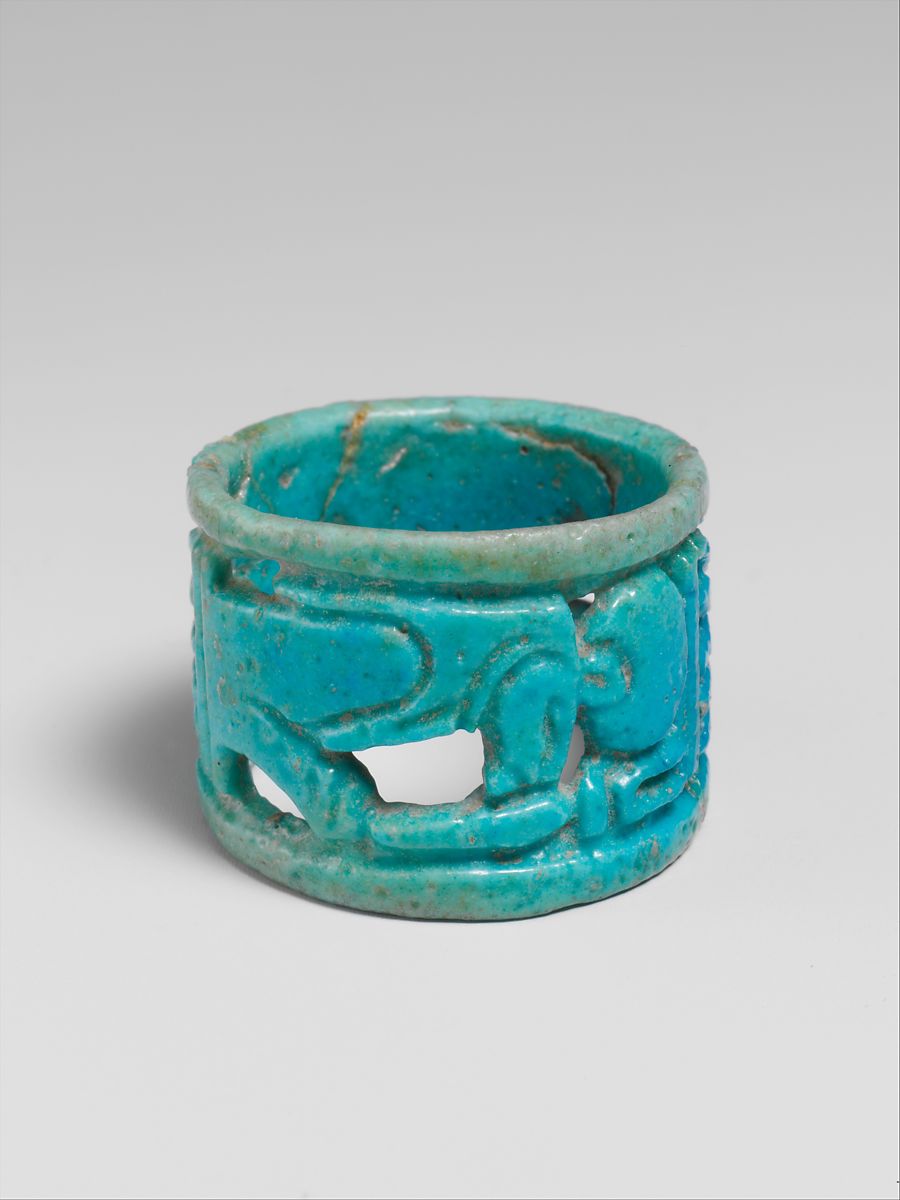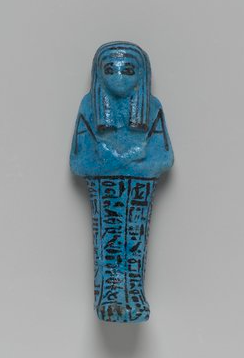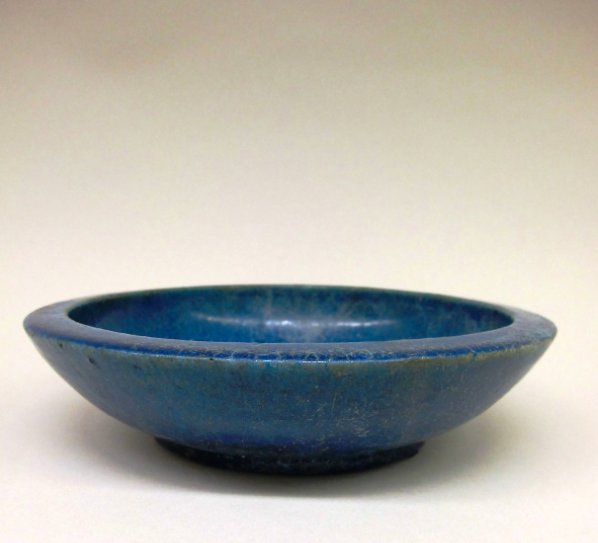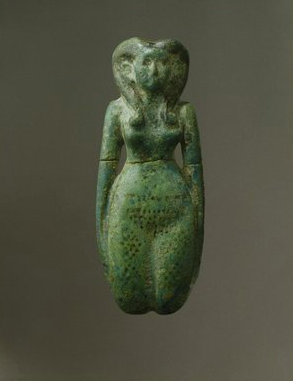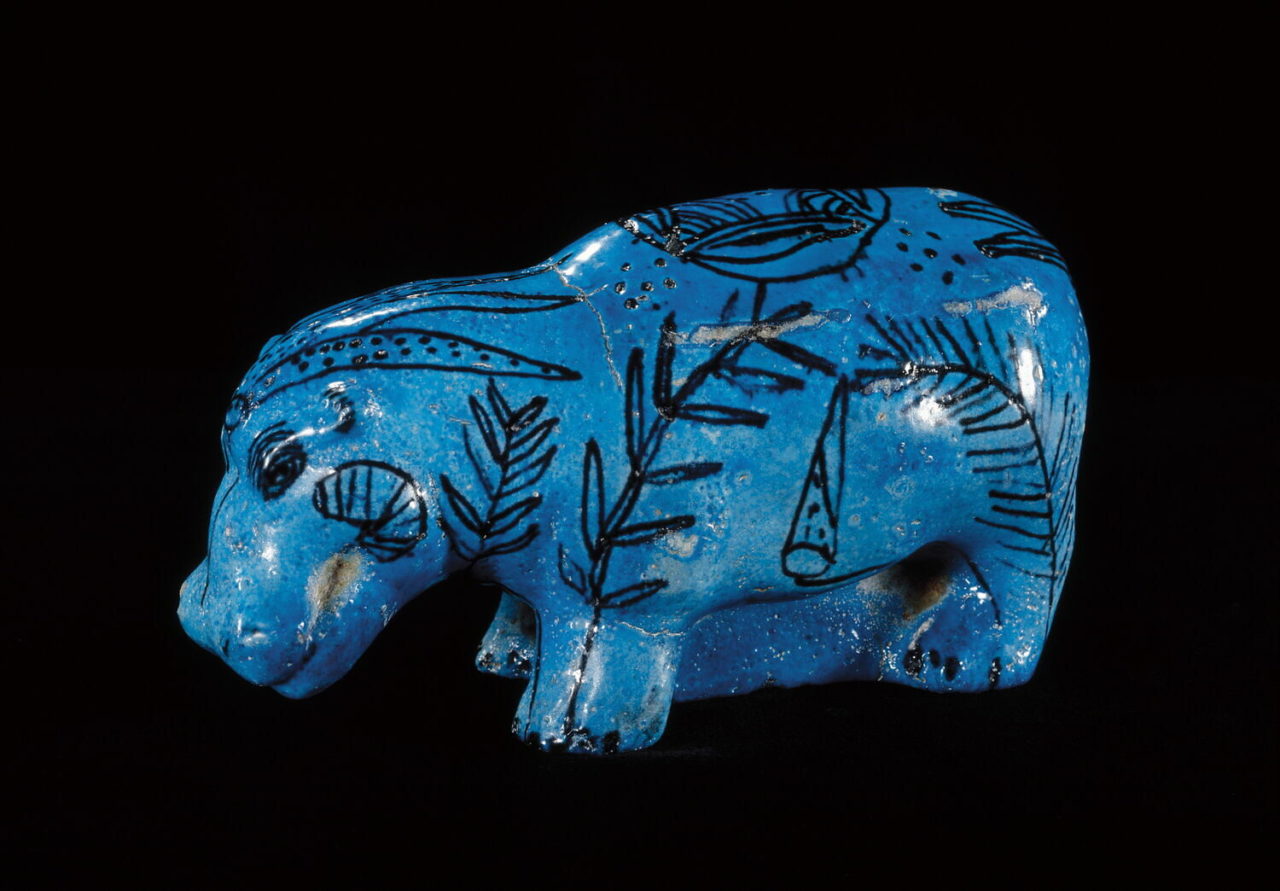Faience is a man-made ceramic material that was often used in ancient Egypt to make jewelry and devotional objects. It is usually a blue color.
The Details
Acommon material in Ancient Egypt, faience was used for many purposes. In “Egyptian Faience: Technology and Production” (2017), the author Carolyn Riccardelli gives a detailed description of what faience is:
“Egyptian faience is a ceramic material with a siliceous body and a brightly colored glaze. In addition to silica, faience also contains alkaline salts (the source of which was either natron or plant ash), minor amounts of lime, and a metallic colorant. Although faience was made in a range of bright colors, the turquoise blue color so characteristic of the material is created with copper. During the firing process, the alkali (acting as a flux) and the lime (acting as a stabilizer) react with the silica in the core to form a glaze on the surface.”
The collection at the Metropolitan Museum of Art includes a brightly colored Egyptian open-work faience ring from 1090-900 BCE (Fig. 1).
In figure 2, a beautifully made Egyptian shabty is shown from ca. 1075-945 BCE in the collection of the Brooklyn Museum. The piece is made of faience and was included in tombs because shabties “perform agricultural work in place of the deceased in the afterlife,” according to the Brooklyn Museum.
An article on ancient Egypt on Grove Art Online describes the meaning and science behind faience:
“Egyptian faience is a manmade compound with a powdered quartz sintered body and alkaline glaze. It is chemically unconnected with the tin-glazed earthenware produced at Faenza in the early 16th century AD, although the range and brightness of the colours employed by Egyptian craftsmen made the Europeans of the day draw comparisons between the two. The alkaline glazes found on Egyptian faience objects are most frequently blue, green or greenish-blue, though sometimes other colours are found. They are essentially sodium–calcium–silicate compounds, consisting of an alkali, such as natron or plant ash, a small amount of copper or other metallic compound for colouring, some calcium carbonate and a large proportion of silica. Such glazes are chemically close to glass and have no lead content.”
Made during the Hellenistic period (332-30 BCE), this faience bowl (Fig. 3) was created in Egypt.
In “The Technique of Egyptian Faience” (1969), the author Joseph Veach Noble describes faience’s significance:
“Faience was the first glazed ceramic material invented by man. It was originated near the end of the fifth millennium B.C. and has been in uninterrupted use to the present time. It may have been invented either in Sumeria or in Egypt but its fullest development and finest achievements were accomplished in Egypt and it is therefore commonly referred to as Egyptian faience.”
The Brooklyn Museum has an Egyptian fertility figure (Fig. 4) made out of faience, dating between 1938 and 1630 BCE.
In “Ancient Egyptian Materials and Technology” (2000), archaeologist Julian Henderson, describes faience:
“Faience is a glazed non-clay ceramic material. It is more correctly defined as ‘Egyptian faience’, in order to differentiate it from a type of pottery, now known as majolica, which is a tin-glazed ware made in Faenze in northern Italy (and elsewhere) from late medieval times onwards.” (177)
Hippos made out of faience are commonly found in museum collections, see for example one from the Louvre Museum (Fig. 5). Another well-known example is “William the Hippo” from the collection at the Met, seen in figure 6, about which the Met writes,
“To the ancient Egyptians, the hippopotamus was one of the most dangerous animals in their world. The huge creatures were a hazard for small fishing boats and other rivercraft. The beast might also be encountered on the waterways in the journey to the afterlife. As such, the hippopotamus was a force of nature that needed to be propitiated and controlled, both in this life and the next.”
Faience had a multitude of uses for the ancient Egyptians, who used it to create not only devotional objects, but decorative and functional pieces as well. The practice of making faience objects developed over thousands of years, and many examples are present in museum collections worldwide today.
Fig. 1 - Artist unknown (Egyptian). Openwork faience ring, ca. 1090–900 B.C.. Faience; 2.5 cm (1 in). New York: The Metropolitan Museum of Art, 74.51.4540. The Cesnola Collection, Purchased by subscription, 1874–76. Source: The Met
Fig. 2 - Artist unknown (Egyptian). Shabty of Nesi-ta-nebet-Isheru, Daughter of Pinedjem II, ca. 1075-945 B.C.E.. Faience; 14.7 x 5.7 x 3.8 cm (5 13/16 x 2 1/4 x 1 1/2 in). New York: Brooklyn Museum, 16.183. Gift of Evangeline Wilbour Blashfield, Theodora Wilbour, and Victor Wilbour honoring the wishes of their mother, Charlotte Beebe Wilbour, as a memorial to their father, Charles Edwin Wilbour. Source: Brooklyn Museum
Fig. 3 - Artist unknown (Egyptian). Faience bowl, 332–30 B.C.. Faience; 22 cm (8 11/16 in). New York: The Metropolitan Museum of Art, 2016.496.2. Gift of Thomas Colville, 2016. Source: The Met
Fig. 4 - Artist unknown (Egyptian). Fertility Figurine, ca. 1938-1630 B.C.E.. Faience; 5.1 x 13.1 cm (2 x 5 3/16 in). New York: Brooklyn Museum, 44.226. Charles Edwin Wilbour Fund. Source: Brooklyn Museum
Fig. 5 - Artist unknown (Egyptian). Figure d'Hippopotame, ca. 1862-1686 B.C.E.. Faience; 12.7 x 20.5 x 8.1 cm. Paris: Louvre Museum, E 7709 A. Source: Louvre
Fig. 6 - Artist unknown (Egyptian). Hippopotamus ("William"), ca. 1961–1878 B.C.E.. Faience; 20 x 7.5 x 11.2 cm. New York: Metropolitan Museum of Art, 17.9.1. Gift of Edward S. Harkness, 1917. Source: The Met
References:
- Henderson, Julian., Serpico, Margaret., Peltenburg, E. J.., White, Raymond., Morkot, Robert., Quirke, Stephen., Tait, John. Ancient Egyptian Materials and Technology. United Kingdom: Cambridge University Press, 2000. http://www.worldcat.org/oclc/852718573
- Metropolitan Museum of Art. “Hippopotamus (“William”).” Metropolitan Museum of Art. Accessed March 23, 2022. https://www.metmuseum.org/art/collection/search/544227
- Noble, Joseph Veach. “The Technique of Egyptian Faïence.” American Journal of Archaeology 73, no. 4 (1969): 435–39. https://doi.org/10.2307/503999.
- Riccardelli, Carolyn. “Egyptian Faience: Technology and Production.” In Heilbrunn Timeline of Art History. New York: The Metropolitan Museum of Art, 2000–. http://www.metmuseum.org/toah/hd/egfc/hd_egfc.htm (December 2017).
- Strudwick, Helen M., et al. “Egypt, ancient.” Grove Art Online. 2003. https://www-oxfordartonline-com.libproxy.fitsuny.edu/groveart/view/10.1093/gao/9781884446054.001.0001/oao-9781884446054-e-7000025075.


